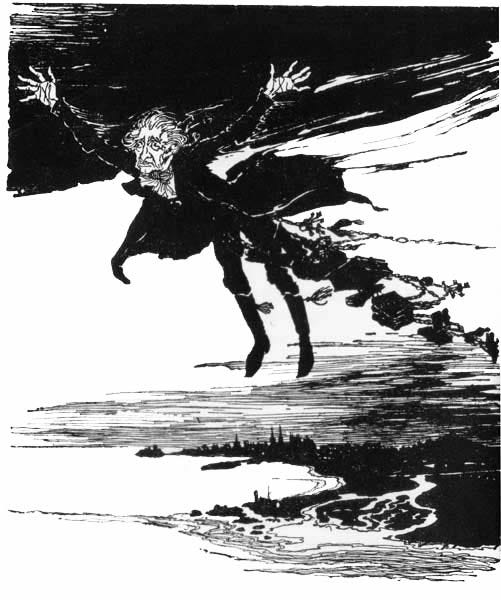Ebenezer Scrooge, Master Lucid Dreamer
Overwrought insufficiently edited Yuletide musings
Perhaps the greatest lucid dreamer in all of Western literature is Ebenezer Scrooge, the main character in Charles Dickens’ A Christmas Carol. Ebenezer has no less than three intense lucid dreams in that novella, preceded by a humdinger of a harbinger of a hallucinatory visitation, before he trip balls through the past, present, and future over the course of one long transformative night. You all know the story.
If Memory serves me right —
which, I’ve noticed, as the years continue to fly by with unsympathetic unrestrainable indifference and the catalog of fragmented sights sounds smells tactile surfaces that constitute my extended experience recede further down into my brain’s more densely cobwebbed reaches of viscoelastic and poroelastic “goo,” it sometimes does not
— my first exposure to A Christmas Carol was not the book (I’m just reading it now, for the first time — Four stars!) but the annual televised broadcast of the 1951 film Scrooge, starring Alastair Sim. It’s an authentic telling of the source material; you can follow along with book in hand while watching.
My favorite part of the movie is when Ebenezer is in the cemetery with the Ghost of Christmas Yet to Come (a.k.a., Death) and he falls down onto his own flat headstone. Our TV’s diagonal length was too short for that scene to scare me all that much, and the general tone of the film was too campy-operatic for my aesthetic taste, even at age seven. (Let it be said: I am no lover of kitsch, of something “so bad it’s good.” Ugly Christmas sweaters? A Barbie movie? Please. I’d rather be gagged with a commemorative Precious Moments spoon.) But still, there was something about the blackness of the cemetery, of Death itself, that piqued my dramatic interest and stayed with me.
In the graveyard, Ebenezer asks the dark Spirit a quintessential dream interpretation question, the same question we might ask should we dream some unsettling scene about our future: “Are these the shadows of the things that Will be, or are they shadows of the things that May be only?” In other words, is this definitive, or is there some psychological wiggle room here? Might we still change, or is this a real dream premonition?
Although he waffles a bit here and there in the story, Ebenezer seems willing to change his miserly ways, right from the get-go, after Marley’s terrifying inciting incident vision, so that he might not suffer the same fate as his former partner. Bring it on! he says, in dream incubation fashion.
I Like Life, Life Likes Me
That cemetery scene was also my favorite part of the 1970 musical film Scrooge starring Albert Finney, which my father took me to see in a movie theatre for my ninth birthday, on Christmas Day, and which did scare the shit out of me. (Screen size matters.) Flying denizens of hell. Grotesquely disfigured spirits. Death’s crooked knuckled pointing finger as Ebenezer falls like a stone into the bowels of hell. (I’ll be savagely disappointed if, in my final moments, Death does not appear, faceless, black-robed, chessboard in hand, and that finger is not a thing.)
Other highlights from the 1970 version rush forward from memory, flow down into my fingertips… … … Ebenezer unwittingly singing and dancing along with the townsfolk as they carry his coffin in procession, celebrating his death: “Thank you very much! Thank you very much! That's the nicest thing that anyone's ever done for me!” Oh, glorious stuff! and a classic musical earworm of a tune… … Sir Alec Guinness’s fabulous turn as the ghost of Marley, sashaying into the room, weird and wild and other-worldly, flapping his hands ever so slightly like a lazy penguin for upward thrust, hovering mid-air all Baron Vladimir Harkonnen gay parade floaty… and, of course, the Ghost of Christmas Present, a ten-foot-tall wreath-crowned Falstaff, munching on a gigantic leg of mutton, drinking mulled wine from an equally gigantic chalice, sitting atop all of life’s shiny loot. His “live for today” credo made a gigantic impression on my young, quarter-Irish malleable mind and remains etched in my worldview to this day — specifically and to wit:
Tempis fugit y’all. Buy that import box set. Ask that pretty girl out. Drink that expensive wine. Buy that new guitar. Move to that new city. Move to that new country. Take that chance — take all the chances, every last one of them. What Are You Waiting For?
Like The Dickens
Dr. Melissa Dickson’s excellent 2020 journal article, “Dickens's nightmare: dreams, memory and trauma,” provides great insight into the intertwining of Charles Dickens’ dreamlife with his fiction and his lived experience.
The OG of a Dickensian upbringing, Dickens’ impoverished childhood informed his best works ("Oliver Twist," "David Copperfield," "Bleak House," "Hard Times") as he chronicled the squalor and poverty of Victorian-era London in true “write what you know” writerly fashion. The inhumane abominations of the factory workplace, the shameless degradation of Nature that the Industrial Revolution produced, all were in full swing when Dickens published A Christmas Carol in 1843. Fortunately, the Revolutions of 1848 that swept through Europe were just around the corner, as they always are in times when wealth becomes over-concentrated into the grubby hands of the greedy few.
You’ll find echoes of Dickens’ childhood when Ebenezer journeys through the past in his first dream.
Dr. Dickson writes:
“Through his series of spectral visions, we learn that Scrooge, like Dickens himself, was a traumatized child neglected by a seemingly capricious, absent father. In an altered state of consciousness, figured here as the infiltration and possession of his normal self by a sequence of ghosts, Scrooge finds himself forced to confront his memories of a troubled childhood and to recognize his kinship with his fellow Londoners.”
Notice how Dickens, through his fictional lucid dream persona Ebenezer, confronts the nightmarish memories of his early life, the same way any modern dreamworker will tell you to confront your nightmares to transform and banish them from your psyche. Indeed, all throughout the tale, Dickens-Ebenezer expertly interprets his dreams in real lucid dreamtime, and he’s pretty darn Jungian spot-on — which is impressive, given that Dickens wrote the story a full 50 years before Freud’s “The Interpretation of Dreams” was published and when William James was still in cotton nappies. And he didn’t have the luxury of the myriad dream interpretation books available to us now.
Ebenezer has lots of flying and DMT-like quantum spatial scene flipping during the course of his night, typical of any good lucid dream —
“As the words were spoken, they passed through the wall, and stood upon an open country road, with fields on either hand. The city had entirely vanished. Not a vestige of it was to be seen. The darkness and the mist had vanished with it, for it was a clear, cold, winter day, with snow upon the ground.”
— although, it being Victorian times and all, his mind never wanders into a side alley for a hanky-panky dream quickie, a respite from the intensity of all his "This Is Your Life” visions. The best he gets is to gaze upon a bit of hoop-skirted square dance galloping at the Fezziwig company Christmas party, to the big hit of the day, “Sir Roger de Coverley.”
The London Nightwalker
Dr. Dickson also notes how Dickens often roamed the streets of London at night, compulsively, for decades, to combat his insomnia. Citing Matthew Beaumont, author of “Nightwalking: A Nocturnal History of London,” Dr. Dickson writes:
“Dickens was, as Matthew Beaumont has demonstrated, ‘a manic – not just an energetic – walker for decades' whose compulsive perambulations of the streets of London at night comprised a desperate search for emotional and psychological relief, and an escape from the stresses and strains of his daily life. The nightwalker's ambition, Beaumont argues, ‘is to lose and find himself in the labyrinth of the city at nighttime’, and ‘every nightwalk is thus a fugue or psychogenic flight – an escape from the self and, at the same time, a plunge into its depths'.
Nightwalking, then, as a psychological break from the conscious self, becomes a substitute not only for sleeping, but also for dreaming, as the shadowy streets seem to liberate the darker recesses of the human psyche.”
An interesting thought, that one’s somnambulist wanderings are equivalent in awareness to the same dark spaces that the unconscious presents during dreamtime. (Travis Bickle might agree.) As someone who has wandered the midnight streets of San Francisco, Vancouver, and other smaller towns, I can say that it merits deeper introspection. Regardless, how Dickens got any sleep is beyond me. Superhuman manic energy is the main fuel of any novelist, and Dickens wrote fifteen of them, many of them a door-stopper length of 300,000 plus words. He also edited a weekly journal, wrote five novellas and hundreds of short stories and non-fiction articles, and lectured and performed readings on a regular basis. He also wrote letters as constantly as we now pop off emails or long-winded Facebook comments. All by quill and ink.
One night, during one of his meanderings, Dickens stood outside a psychiatric hospital and pondered the landscape of the dreaming mind, comparing our nightly forays into the unconscious slumberland to a form of insanity:
“Are not the sane and insane equal at night as the sane lie a dreaming? Are not all of us outside this hospital, who dream, more or less in the condition of those inside it, every night of our lives? […] Do we not nightly jumble events and personages and times and places, as these do daily? Are we not sometimes troubled by our own sleeping inconsistencies, and do we not vexedly try to account for them or excuse them, just as these do sometimes in respect of their waking delusions?”
This of course echoes the prevailing wisdom of the day, of the nonsensical insanity of the dream life. Nothing to see here folks, move on. Quit your dreaming!
Happy Visions
It’s interesting that Dickens should make an analogy of dreams to insanity when his own dream life was so vivid and strong. I guess he just couldn’t square the circle.
For example, on the death of his sister-in-law Mary, Dickens writes:
“Is it not extraordinary that the same dreams which have constantly visited me since poor Mary died follow me everywhere? After all the change of scene and fatigue, I have dreamt of her ever since I left home, and no doubt shall till I return. I should be sorry to lose such visions, for they are very happy ones, if it be only the seeing her in one's sleep. I would fain believe, too, sometimes, that her spirit may have some influence over them, but their perpetual repetition is extraordinary.”
As Jeanne Van Bronkhorst mentions in her book “Dreams at the Threshold: Guidance, Comfort, and Healing at the End of Life,” it’s quite common to dream of loved ones after they have passed. These dreams can be quite comforting in our time of grief and mourning.
I’m reminded of the 1924 song, “I’ll Be Seeing You In My Dreams:”
Tho' the days are long, twilight sings a song
Of the happiness that used to be
Soon my eyes will close, soon I'll find repose
And in dreams you're always near to me
I'll see you in my dreams, hold you in my dreams,
Someone took you out of my arms, still I feel the thrill of your charms
Lips that once were mine, tender eyes that shine
They will light my way tonight, I'll see you in my dreams
Endnotes
It was fun researching and revisiting those old films. It’s been a while since I’ve given old Ebenezer any more than a cursory thought, what with being too busy entertaining myself within the halls of Ghosts of Christmases Present. But as I approach my autumnal years on tippy-toes, trying not to draw too much attention to myself lest I catch Death’s attention prematurely, A Christmas Carol takes on a deeper, more personal meaning. I find myself wondering about the blackness of my own demise, that hole that awaits me, the hole that awaits us all. All I ask is this: the pure vision of that crooked finger of Death, pointing clearly and unmistakably at me, and I can die a happy man.
Speaking of which, The Christmas Baby Club lost a couple of Titans this year. Jimmy Buffet and Shane MacGowan now belong to the ages as people often say. I like to imagine them approaching Saint Peter’s pearlies, arm in arm, drinks in hand, singing the most sublime two-part harmony version of “Margaritaville” you’ve ever heard. You can hear it too, right?
So Merry Christmas and Happy Holidays to everyone, one and all. And let us take a solemn moment to not forget the lesser among us, those beady-eyed greedy-hided men who hoard our commonwealth, who can only feel good about themselves when they have more than others. May they have the requisite lucid dreams, complete with Ebenezer denouement, required to inspire a Christmas morning Charles Feeney-esque deflation of ego, a Grinchian transformative change of heart, to help lift our world out of its present state of despair. “God and sinners reconciled!” Once, and for all.













Wonderful article!
Yes! I would even venture to say, sleep paralysis sufferer. One thing that SP folks say is they often have a weird feeling in the evening before they have an experience, and sometimes a premonition or synchronicity. After the doorbell, he falls asleep in the chair. Classic hypnagogic vision power move! And the description of Marley approaching is so resonate with many SP intruder visions -- the shuffling footsteps, the dragging sounds (of chains in this case), the focus on the doorway as liminal zone/boundary. I think Dickens was drawing from personal experience and that’s one reason the story resonates still today